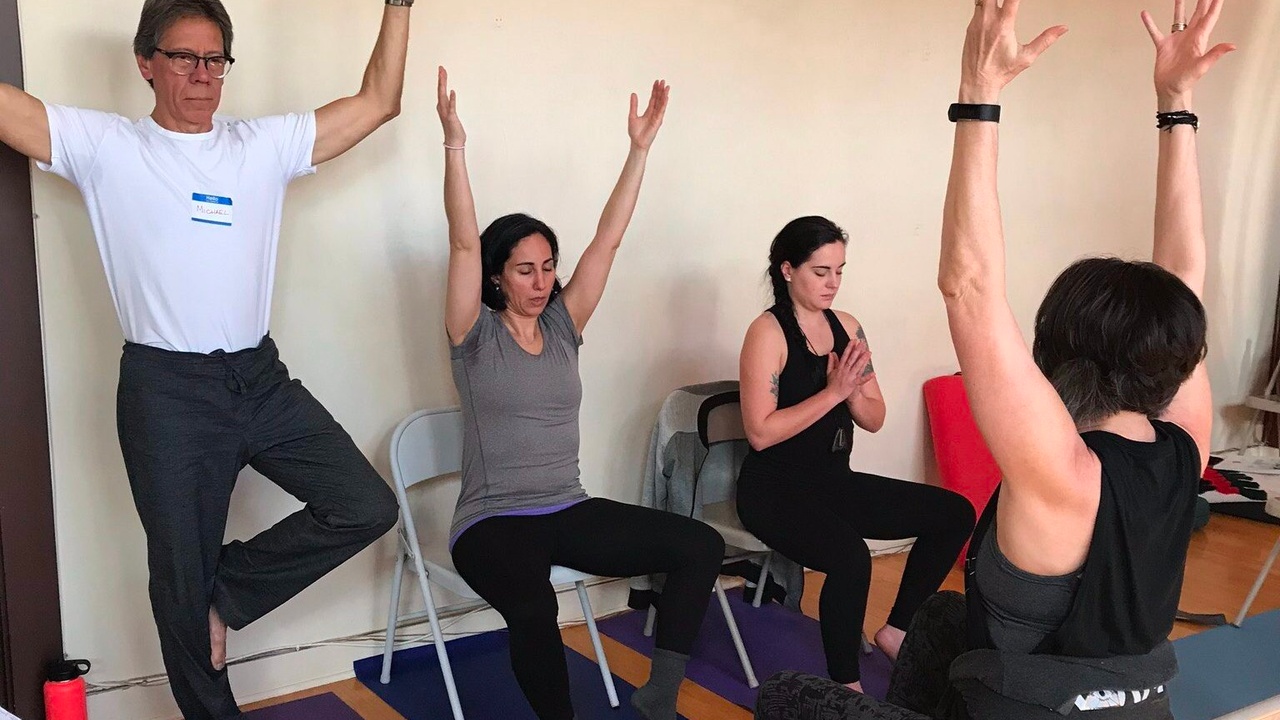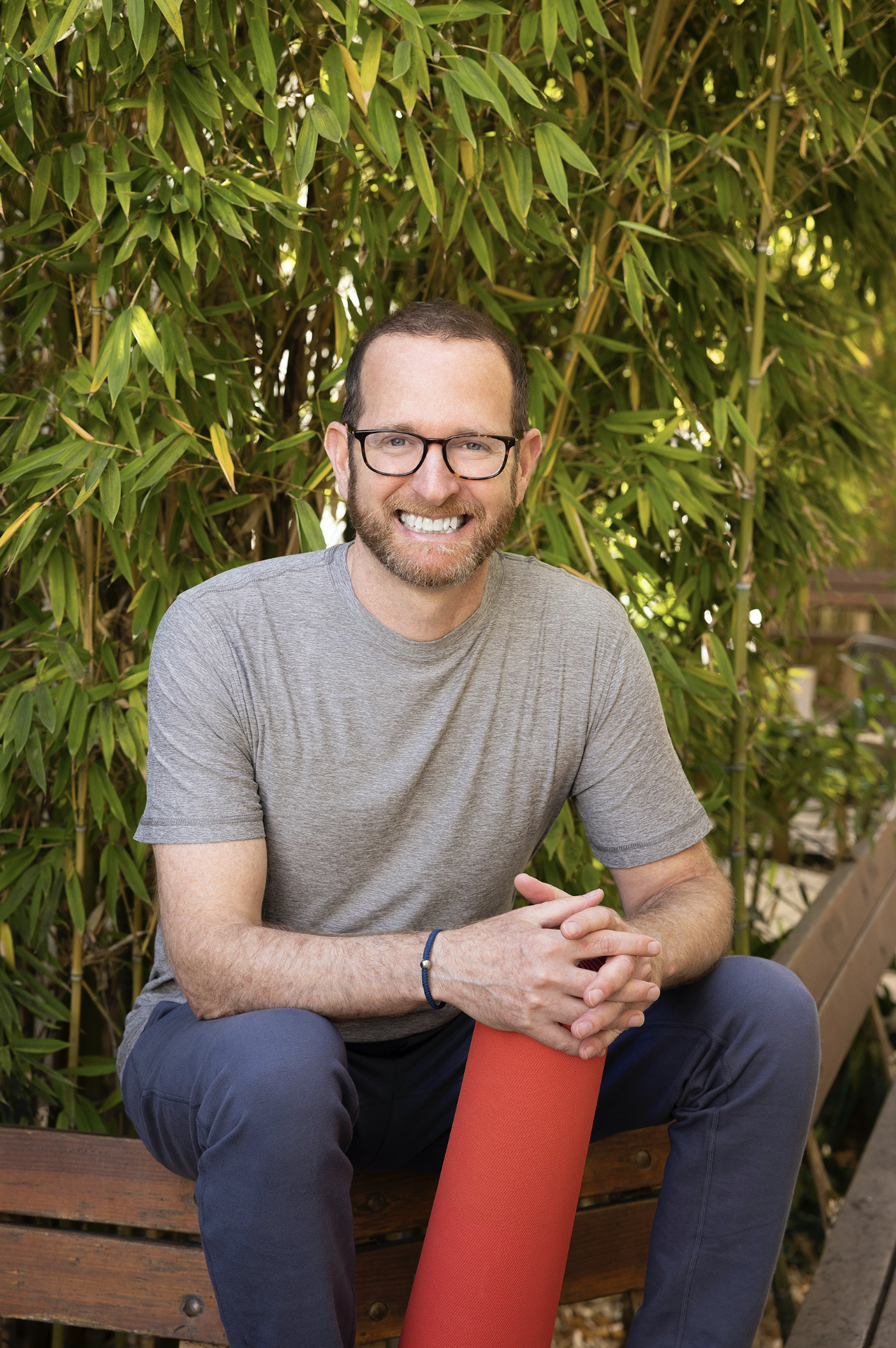A Technique to Teach Truly Mixed Level Yoga Classes

by Jivana Heyman
As yoga teachers, we need to help our students find safe and effective ways to practice whether it’s online or in person. One of the most helpful ways of doing this is to offer many variations and options for every practice that we teach. And even more importantly, to avoid a hierarchy in our teaching which can lead students to think that doing a more physically advanced practice equates with advanced yoga, when it really doesn’t.
Advanced yoga is heightened sensitivity to our inner world potentially leading to connection with our spirit or true self.
Physically advanced poses can be fun, but they are not essential for deepening our yoga practice. One way to emphasize this point is to teach integrated classes where students are practicing at multiple levels at the same time, some on the mat and some in chairs. Or where students are doing a variety of variations on the mat, but there is some central theme or focus to the practice.
The way I approach this is by making sure that my instruction integrates all the students into the same practice rather than teaching one version to one group of students and then separately teaching a different practice to another group. Even though we mean well when we do this, in my opinion it sets up a scenario where one group feels separate, and even less than, another group.
What I do instead is focus on creating an integrated experience for all the students.
The technique I use when integrating mat and chair practice, is to first teach the preparatory position of the pose, which is usually the foundation, in the chair and on the mat separately.
So, if I’m teaching Tree Pose, I might teach the preparatory position on the mat, having students in the chair bring one leg out to the side, placing that heel against the leg of the chair. On the mat, I would have students prepare the foundation of the pose by raising one leg, and beginning to balance on the other. Then I would give a universal instruction for both groups to come into the fullness of the pose together. For example, “Everyone, exhale, ground down into your supporting foot, then inhale, lengthen the spine and bring the hands together at the heart. If you feel balanced, raise the arms overhead. Keep the eyes focused on one point and the breath relaxed. Then come down together....”
The idea behind this technique of Prepare Separately and Practice Together is that we can find different ways into a pose but in the end we’re doing the practice as a group, creating an integrated experience where everyone present is participating equally regardless of the form their body is in.
This can help to cultivate a sense of equity and a true feeling of acceptance no matter what our ability or disability may be.
Want to learn more?
Join our upcoming FREE mini-workshops with Jivana! ⤵️
3 Ways to Adapt Sun Salutation to Make It Truly Accessible
January 6, 2023 | 12-1pm PST
In this session, Jivana Heyman will offer a variety of techniques to expand your toolkit and help make your classes accessible, welcoming, and effective. He'll also discuss his upcoming 38-Hour Accessible Yoga Training Online.
Register here
Plus, FREE 3-Part Mini-Workshop Series!
Are You The Yoga Teacher For Everyone?
On Demand Now!
Jivana Heyman and M Camellia share their thoughts on a big but common question—is it possible to be the yoga teacher for everyone?
How Do You Plan A Yoga Class?
January 16, 2023 | 10:30-11:30am PST
Join Mukunda Marc Morozumi and Jivana Heyman for discussion and short practices with tips for how to plan a yoga class.
Infusing Yoga Philosophy Into Your Teaching
February 2,2023 | 11am-12pm PST
Join Anjali & Jivana as they share their experience and tips for infusing yoga philosophy into your teaching and practice.
Register here to access all three sessions
About the Author

Jivana Heyman, C-IAYT, E-RYT500, is the founder and director of the Accessible Yoga Association, an international non-profit organization dedicated to increasing access to the yoga teachings. He’s the author of Accessible Yoga: Poses and Practices for Every Body (Shambhala Publications), as well as the forthcoming book, Yoga Revolution: Building a Practice of Courage & Compassion (Shambhala Publications, Nov. 2021).
Jivana has specialized in teaching yoga to people with disabilities with an emphasis on community building and social engagement. Out of this work, the nonprofit Accessible Yoga Association was created to support education, training, and advocacy with the mission of shifting the public perception of yoga. Accessible Yoga offers Conferences, Community Forums, a Podcast, and a popular Ambassador program.
Jivana coined the phrase, “Accessible Yoga,” over ten years ago, and it has now become the standard appellation for a large cross section of the immense yoga world. He brought the Accessible Yoga community together for the first time in 2015 for the Accessible Yoga Conference, which has gone on to become a focal point for this movement.
Jivana is also the creator of the Accessible Yoga Training and the co-founder of the online Accessible Yoga School with Amber Karnes, which is a platform for continued education for yoga teachers in the field of equity and accessibility. They also created the Accessible Yoga Podcast in 2020.
Over the past 25 years, Jivana has led countless yoga teacher training programs around the world, and dedicates his time to supporting yoga teachers who are working to serve communities that are under-represented in traditional yoga spaces.

